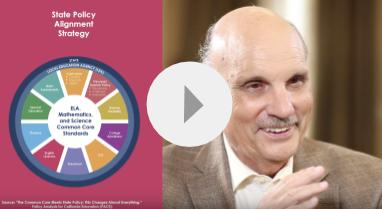What Does the Superintendent of Public Instruction Do?

California's Constitutional Education Leader
On the afternoon of July 20, over a thousand high school students selected for the 2020 Ed100 Academy for California Student Leaders will have a chance to meet Tony Thurmond, the state Superintendent of Public Instruction (SPI).
This seems a reasonable time to answer a complex question: what does the SPI do?
The office of Superintendent of Public Instruction is a complex non-partisan role. The position was created in 1849 as part of California's first Constitution (which, like Ed100, was written in both English and Spanish). Similar to the office of Attorney General or Treasurer, voters in California elect the state superintendent directly. This independence is rare: in most states the governor or the state board of education appoints the top education official.
Narrow Power, and a Bully Pulpit
The core role of the SPI is operational leadership and administration of the California Department of Education (CDE). In effect, the SPI serves as the state's top education bureaucrat, but with a bully pulpit to influence the direction of education policies. The powers of the office are defined by a dense thicket of state and federal laws.
In fact, it is almost easier to define the office of Superintendent of Public Instruction by its limits than by its powers.
|
Narrow Powers of the Superintendent of Public Instruction |
|
|---|---|
Doesn't make law | The SPI doesn't make education-related law — that is the shared function of the Assembly, the Senate and the Governor. However, the Superintendent can influence legislation. The staff of the Department of Education is often consulted, because of its deep familiarity with the Education Code. |
Not a court | The SPI does not rule on court cases involving education law — that is the function of the judicial branch of government. But the Department of Education plays an important role in resolving complaints of violations. |
Doesn't Control Budget | The SPI doesn't control the state education budget — that's determined by a combination of the stock market, voter initiatives (notably Proposition 98) and the budget process, in which the SPI has no vote. |
Doesn't Control Policy | Most education policy implementation choices aren't under the control of the SPI, either. In 1993 the California court of appeal ruled in SBE v. Honig that the Department of Education must follow the decisions of the State Board of Education, the members of which are appointed by the governor. |
Doesn't Control Textbooks | The SPI doesn't direct the content of learning materials. That's the job of the Instructional Quality Commission of the State Board of Education. |
Doesn't Certify Teachers | The certification of teachers isn't under the control of the SPI — that's the role of the independently-appointed Commission on Teacher Credentialing. But the SPI sits on the board. |
Doesn't Control Facilities | School facilities? No, that's handled by the State Allocation Board. But the SPI sits on the board. |
Doesn't Rescue Schools | School districts in financial crisis? Mostly no, that's usually work for the Fiscal Crisis Management and Assistance Team (FCMAT), which is managed by Kern County. But the SPI appoints a deputy as a member. |
Doesn't Do Turnarounds | Schools in deep academic crisis? No, that's work for the new California Collaborative for Education Excellence (CCEE), which will be managed out of Marin County. But the SPI sits on the board. |
Doesn't Oversee Colleges | The SPI has no official role in the day to day governance of the state's community colleges, which educate more students than the UC and CSU systems combined. (The SPI does, however, sit as a member of the board of regents of the University of California and the board of trustees of the CSU system.) |
Operational power
The California Department of Education is a big organization, with about 2,500 employees throughout the state. Of these, nearly a thousand are teachers and staff in regional schools for the deaf and blind. Hundreds more work in federally-supported programs such as administration and oversight of school food services.
Despite its size, the CDE is a tiny part of the education system. California's education system is enormous, with over 6.2 million students and over half a million teachers and staff in K-12 alone. Most of the work happens in schools and districts, not in Sacramento.
The California Department of Education has a well-deserved reputation for bureaucracy, partly because that is the role lawmakers tend to give it. California's Education Code has no single author. It is the chaotic sum of decades of work by lawmakers in a political system. The CDE (and with it, the Superintendent) is regularly tasked with carrying out these laws or ensuring that others do so.
The CDE is responsible for providing the public with accurate and useful data
One of the CDE's most crucial responsibilities is to provide the public with accurate and useful data that can help school systems function and improve. To be blunt, the state has never had the capacity to perform this role. Under prior California governors, data systems explicitly were not a priority. In the context of a pandemic creating them is a virtually impossible task, especially because California is so far behind other states in this work. California's education system operates in a fog that will take years to clear.
Another notable function of the Superintendent of Public Instruction is to serve as the administrator of last resort when a school district implodes financially. Happily, this has happened quite rarely thanks to a pattern of successful oversight by county offices of education, even during the Great Recession. When it does happen, though, the SPI is shoved into the role of designated villain. In practice, the SPI appoints an administrator to oversee the turnaround process, which often involves some tough love and litigation. Under these conditions, generally local school boards lose their independence. The appointed administrator calls the shots.
As the financial impacts of the pandemic work their way through the economy, school budgets will almost inevitably be wiped out like sandcastles on a beach. The only realistic alternative would be a massive infusion of federal funds supported by higher federal debt.
California Education's Multi-Headed Beast
For more than a decade, the leaders of California's education system have agreed a lot more than they have disagreed, at least on this big issues. This level of agreement has been historically rare. As described above, authority in the education system is highly distributed. When the SPI, the State Board, the Governor and Legislative leaders disagree, state governance of education can become a "many headed beast."
Convening, Connecting and Cajoling
The education system operates in parts, each with its own priorities and perspectives. Even when those parts function well individually it does not necessarily follow that the parts will align. The Superintendent of Public Instruction has the difficult task of creating conditions for educational success at a level greater than the sum of the parts. Prior Superintendents of Public Instruction have used the art of political persuasion to support major policy changes. For example, Delaine Eastin championed smaller class sizes and county oversight of district budgets. Jack O'Connell highlighted the need to close the achievement gap. Tom Torlakson led an initiative to increase the number of students proficient in more than one language.
In 2018, Superintendent Thurmond took leadership of a freshly remodeled education system with a lot going for it, including a growing sense that "alignment" can make a difference. Mike Kirst, the long-serving president of the California State Board of Education, is widely viewed as a lead architect of this remodel, which has involved hard-fought changes in standards, curriculum, assessment, finance and more. He explains the vision for "alignment" in this short video:
This strategic direction has won an impressive degree of support in California. Despite the disruption of the pandemic, implementation has nevertheless begun for many elements of the vision, which Kirst may describe when he speaks at the Ed100 Academy for Student Leaders.
Gaps certainly remain, however. The state critically lacks a cohesive system for early childhood learning, and when the pandemic began Governor Newsom quickly scuttled plans to invest in improving it. The state has also deferred the essential work of creating a system of teacher "capacity building" and evaluation.
Dramatic improvement of the state's education data systems will be a necessary step in that work. Anyone who has ever designed, built, rolled out or lived through a data system remodel project will tell you: it's hard to execute well and easy to get wrong. The Dilbert cartoons on the cubicle walls of IT departments are there for a reason.
Back to that Bully pulpit
Policy positions aren't all that matter, of course. As described above, the SPI formally has less to do with calling the shots than with carrying them out through organizational leadership. But the office of Superintendent is also a bully pulpit. The SPI is the state's chief public advocate for the Big Idea of public education: each child matters and we all benefit when every child learns.
Superintendent Thurmond has taken leadership at a time of crisis, when schools are struggling to make distance learning work for all students. Thurmond has made it clear that racial justice in education will be an important theme of his leadership.
Tags on this post
Civics History Policy Superintendent PandemicAll Tags
A-G requirements Absences Accountability Accreditation Achievement gap Administrators After school Algebra API Arts Assessment At-risk students Attendance Beacon links Bilingual education Bonds Brain Brown Act Budgets Bullying Burbank Business Career Carol Dweck Categorical funds Certification CHAMP Change Character Education Chart Charter schools Civics Class size CMOs Collective bargaining College Common core Community schools Contest Continuous Improvement Cost of education Counselors Creativity Crossword CSBA CTA Dashboard Data Dialogue District boundaries Districts Diversity Drawing DREAM Act Dyslexia EACH Early childhood Economic growth EdPrezi EdSource EdTech Effort Election English learners Equity ESSA Ethnic studies Ethnic studies Evaluation rubric Expanded Learning Facilities Fake News Federal Federal policy Funding Gifted Graduation rates Grit Health Help Wanted History Home schools Homeless students Homework Hours of opportunity Humanities Independence Day Indignation Infrastructure Initiatives International Jargon Khan Academy Kindergarten LCAP LCFF Leaderboard Leadership Learning Litigation Lobbyists Local control Local funding Local governance Lottery Magnet schools Map Math Media Mental Health Mindfulness Mindset Myth Myths NAEP National comparisons NCLB Nutrition Pandemic Parcel taxes Parent Engagement Parent Leader Guide Parents peanut butter Pedagogy Pensions personalized Philanthropy PISA Planning Policy Politics population Poverty Preschool Prezi Private schools Prize Project-based learning Prop 13 Prop 98 Property taxes PTA Purpose of education puzzle Quality Race Rating Schools Reading Recruiting teachers Reform Research Retaining teachers Rigor School board School choice School Climate School Closures Science Serrano vs Priest Sex Ed Site Map Sleep Social-emotional learning Song Special ed Spending SPSA Standards Strike STRS Student motivation Student voice Success Suicide Summer Superintendent Suspensions Talent Teacher pay Teacher shortage Teachers Technology Technology in education Template Test scores Tests Time in school Time on task Trump Undocumented Unions Universal education Vaccination Values Vaping Video Volunteering Volunteers Vote Vouchers Winners Year in ReviewSharing is caring!
Password Reset
Search all lesson and blog content here.
Login with Email
We will send your Login Link to your email
address. Click on the link and you will be
logged into Ed100. No more passwords to
remember!















Questions & Comments
To comment or reply, please sign in .
Alisa Sabshin-Blek August 25, 2020 at 9:33 pm
Maya Caparaz July 20, 2020 at 12:25 pm